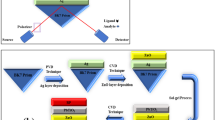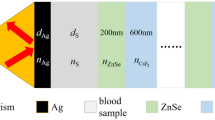Abstract
A lossy mode resonance (LMR) prism-based refractive index (R.I.) sensor theoretical model is presented here. LMR sensor consists of a multilayer configuration of Cytop, perovskite (Cs2AgBiBr6), LiF, and sensing medium. The sensor's characteristics under angular interrogation are significantly enhanced by using the Cytop as the matching layer and Cs2AgBiBr6 as the lossy layer. This paper also summarizes the design concepts for the device and investigates the consequences of modifications in the sensor structure on the reflectance. The device has sensing characteristics under T.E. and T.M. polarized light, and the results demonstrate that its R.I. detection range is between 1.33 and 1.40. This LMR sensor has a maximum quality factor of 2338 RIU−1 under T.M. and 9937 RIU−1 under T.E. polarized light and a sensitivity range of 53–100/RIU under T.M./T.E. polarized light. Malaria has been detected in the human blood. All four stages of malaria have been identified. The parameters have been calculated for the four-stage normal, ring, trophozoite, and schizont of malaria.








Similar content being viewed by others
Data availability
No data available.
Code availability
Not applicable.
References
Y. Zhang et al., Theoretical modeling and investigations of lossy mode resonance prism sensor based on TiO2 film. Opt. Express 30(18), 32483 (2022). https://doi.org/10.1364/oe.466170
O. Fuentes, I. Del Villar, J.M. Corres, I.R. Matias, Lossy mode resonance sensors based on lateral light incidence in nanocoated planar waveguides. Sci. Rep. 9(1), 1–10 (2019). https://doi.org/10.1038/s41598-019-45285-x
B. Saparov, D.B. Mitzi, Organic-Inorganic perovskites: structural versatility for functional materials design. Chem. Rev. 116(7), 4558–4596 (2016). https://doi.org/10.1021/acs.chemrev.5b00715
G. Kakavelakis, M. Gedda, A. Panagiotopoulos, E. Kymakis, T.D. Anthopoulos, K. Petridis, Metal halide perovskites for high-energy radiation detection. Adv. Sci. 7(22), 1–33 (2020). https://doi.org/10.1002/advs.202002098
F. Maddalena et al., Inorganic, organic, and perovskite halides with nanotechnology for high-light yield x- and γ-ray scintillators. Crystals 9(2), 88 (2019). https://doi.org/10.3390/cryst9020088
A. Kojima, K. Teshima, Y. Shirai, T. Miyasaka, Organometal halide perovskites as visible-light sensitizers for photovoltaic cells. J. Am. Chem. Soc. 131(17), 6050–6051 (2009)
R.W. Wood, On a remarkable case of uneven distribution of light in a diffraction grating spectrum. Proc. Phys. Soc. London 18(1), 269–275 (1901). https://doi.org/10.1088/1478-7814/18/1/325
R.W. Wood, Gratznqs with controlled groove sbrm and abnormal distribution of lntensity”, London, Edinburgh. Dublin Philos. Mag. J. Sci. 23(134), 310–317 (1912)
H.H. Nguyen, J. Park, S. Kang, M. Kim, Surface plasmon resonance: a versatile technique for biosensor applications. Sensors (Switzerland) 15(5), 10481–10510 (2015). https://doi.org/10.3390/s150510481
I. Del Villar et al., Optical sensors based on lossy-mode resonances. Sens. Actuators, B Chem. 240, 174–185 (2017). https://doi.org/10.1016/j.snb.2016.08.126
O. Fuentes, I. Del Villar, I. Dominguez, J.M. Corres, I.R. Matías, Simultaneous generation of surface plasmon and Lossy mode resonances in the same planar platform. Sensors 22(4), 1–11 (2022). https://doi.org/10.3390/s22041505
V. Semwal, A.M. Shrivastav, R. Verma, B.D. Gupta, Surface plasmon resonance based fiber optic ethanol sensor using layers of silver/silicon/hydrogel entrapped with ADH/NAD. Sens. Actuators, B Chem. 230, 485–492 (2016). https://doi.org/10.1016/j.snb.2016.02.084
M.F.S. Ferreira et al., Roadmap on optical sensors. J. Opt. 176(5), 139–148 (2018). https://doi.org/10.1088/2040-8986/aa7419
A.D. Tjandra, J.Y.H. Chang, S. Ladame, R. Chandrawati, Opt. sens. (2019). https://doi.org/10.1016/B978-0-12-813886-1.00003-6
A. Ozcariz, C. Ruiz-Zamarreño, F.J. Arregui, A comprehensive review: materials for the fabrication of optical fiber refractometers based on lossy mode resonance. Sensors (Switzerland) 20(7), 1–23 (2020). https://doi.org/10.3390/s20071972
I. Vitoria, C.R. Zamarreño, A. Ozcariz, I.R. Matias, Fiber optic gas sensors based on lossy mode resonances and sensing materials used therefor: a comprehensive review. Sensors (Switzerland) 21(3), 1–26 (2021). https://doi.org/10.3390/s21030731
Vikas, S.K. Mishra, A.K. Mishra, P. Saccomandi, R.K. Verma, Recent advances in lossy mode resonance-based fiber optic sensors: a review. Micromachines 13(11), 1921 (2022). https://doi.org/10.3390/mi13111921
A. Urrutia, J. Goicoechea, F.J. Arregui, “Optical fiber sensors based on nanoparticle-embedded coatings. J. Sens. (2015). https://doi.org/10.1155/2015/805053
A.K. Mishra, S.K. Mishra, B.D. Gupta, SPR based fiber optic sensor for refractive index sensing with enhanced detection accuracy and figure of merit in visible region. Opt. Commun. 344, 86 (2015)
F. Sohrabi, S.M. Hamidi, Neuroplasmonics: from Kretschmann configuration to plasmonic crystals. Eur. Phys. J. Plus 131(7), 1–15 (2016). https://doi.org/10.1140/epjp/i2016-16221-5
L. Wu, Y. Xiang, Y. Qin, Lossy-mode-resonance sensor based on perovskite nanomaterial with high sensitivity. Opt. Express 29(11), 17602 (2021). https://doi.org/10.1364/oe.426409
D. Kaur, V.K. Sharma, A. Kapoor, High sensitivity lossy mode resonance sensors. Sens. Actuators, B Chem. 198, 366–376 (2014). https://doi.org/10.1016/j.snb.2014.03.058
M. Heidari et al., A high-performance TE modulator/TM-pass polarizer using selective mode shaping in a VO2-based side-polished fiber. Nanophotonics 10(13), 3451–3463 (2021). https://doi.org/10.1515/nanoph-2021-0225
M. Kumar, A. Kumar, R. Saini, M.K. Khanna, G. Bhatt, A. Kapoor, Effect of high index buffer layer in PbSe clad waveguide to design a visible range polarizer. Optik 228, 166001 (2021). https://doi.org/10.1016/j.ijleo.2020.166001
B. Karki, K.C. Ramya, R.S.S. Devi, V. Srivastava, A. Pal, Titanium dioxide, black phosphorus and bimetallic layer-based surface plasmon biosensor for formalin detection: numerical analysis. Opt. Quant. Electron. 54(7), 451 (2022). https://doi.org/10.1007/s11082-022-03875-6
B. Karki, A. Uniyal, T. Sharma, A. Pal, V. Srivastava, Indium phosphide and black phosphorus employed surface plasmon resonance sensor for formalin detection: numerical analysis. Opt. Eng. 61(1), 17101 (2022)
B. Karki, A. Jha, A. Pal, V. Srivastava, Sensitivity enhancement of refractive index-based surface plasmon resonance sensor for glucose detection. Opt. Quant. Electron. 54(9), 1–13 (2022). https://doi.org/10.1007/s11082-022-04004-z
A.O. AlGhaithi, S.A. Aravindh, M.N. Hedhili, T.K. Ng, B.S. Ooi, A. Najar, Optical properties and first-principles study of CH3NH3PbBr3Perovskite structures. ACS Omega 5(21), 12313–12319 (2020). https://doi.org/10.1021/acsomega.0c01044
L.K. Ono, E.J. Juarez-Perez, Y. Qi, Progress on perovskite materials and solar cells with mixed cations and halide anions. ACS Appl. Mater. Interfaces 9(36), 30197–30246 (2017). https://doi.org/10.1021/acsami.7b06001
S. Brittman, E.C. Garnett, Measuring n and k at the microscale in single crystals of CH3NH3PbBr3 Perovskite. J. Phys. Chem. C 120(1), 616–620 (2016). https://doi.org/10.1021/acs.jpcc.5b11075
B. Karki, A. Uniyal, G. Srivastava, A. Pal, Black phosphorous and cytop nanofilm-based long-range SPR sensor with enhanced quality factor. J. Sens. (2023). https://doi.org/10.1155/2023/2102915
W. Huang et al., Label-free brain injury biomarker detection based on highly sensitive large area organic thin film transistor with hybrid coupling layer. Chem. Sci. 5, 416–426 (2014). https://doi.org/10.1039/c3sc52638k
P. Laporte, J.L. Subtil, Refractive index of LiF from 105 to 200 nm. J. Opt. Soc. Am. 72(11), 1558–1559 (1982). https://doi.org/10.1364/JOSA.72.001558
G. Young, X. Liu, C. Leng, J. Yang, H. Huang, “Refractive index of [100] lithium fluoride under shock pressures up to 151 GPa.” AIP Adv. (2018). https://doi.org/10.1063/1.5065543
A. Uniyal, B. Chauhan, A. Pal, V. Srivastava, InP and graphene employed surface plasmon resonance sensor for measurement of sucrose concentration: a numerical approach. Opt. Eng. 61(5), 057103 (2022). https://doi.org/10.1117/1.OE.61.5.057103
A. Uniyal, A. Pal, B. Chauhan, Long-range spr sensor employing platinum diselenide and cytop nanolayers giving improved performance. Phys. B Condens. Matter 649, 414487 (2022). https://doi.org/10.2139/ssrn.4230023
A.H.M. Almawgani et al., Titanium disilicide, black phosphorus-based surface plasmon resonance sensor for dengue detection. Plasmonics (2023). https://doi.org/10.1007/s11468-023-01856-3
G. Ansari, A. Pal, A.K. Srivastava, G. Verma, Detection of hemoglobin concentration in human blood samples using a zinc oxide nanowire and graphene layer heterostructure based refractive index biosensor. Opt. Laser Technol. 164(2), 111 (2023). https://doi.org/10.1016/0030-3992(80)90045-6
S.A. Taya et al., Highly sensitive sensor based on SPR nanostructure employing graphene and perovskite layers for the determination of blood hemoglobin concentration. Optik 281, 170857 (2023). https://doi.org/10.1016/j.ijleo.2023.170857
B. Karki, A. Uniyal, A. Pal, V. Srivastava, Advances in surface plasmon resonance-based biosensor technologies for cancer cell detection. Int. J. Opt. 2022, 1476254 (2022). https://doi.org/10.1155/2022/1476254
A. Uniyal, B. Chauhan, A. Pal, Y. Singh, Surface plasmon biosensor based on Bi2Te3 antimonene heterostructure for the detection of cancer cells. Appl. Opt. 61(13), 3711–3719 (2022)
B. Karki, B. Vasudevan, A. Uniyal, A. Pal, V. Srivastava, Hemoglobin detection in blood samples using a graphene-based surface plasmon resonance biosensor. Optik 270, 169947 (2022). https://doi.org/10.1016/j.ijleo.2022.169947
B. Karki, A. Uniyal, B. Chauhan, A. Pal, Sensitivity enhancement of a graphene, zinc sulfide-based surface plasmon resonance biosensor with an Ag metal configuration in the visible region. J. Comput. Electron. 21(2), 445–452 (2022). https://doi.org/10.1007/s10825-022-01854-4
A. Uniyal, G. Srivastava, A. Pal, S. Taya, A. Muduli, Recent advances in optical biosensors for sensing applications: a review. Plasmonics 18(2), 735–750 (2023). https://doi.org/10.1007/s11468-023-01803-2
B. Karki, Y. Trabelsi, A. Uniyal, A. Pal, Zinc sulfide, silicon dioxide, and black phosphorus based ultra-sensitive surface plasmon biosensor. Opt. Quantum Electron. (2022). https://doi.org/10.1007/s11082-021-03480-z
A. Pal, A. Jha, A theoretical analysis on sensitivity improvement of an SPR refractive index sensor with graphene and barium titanate nanosheets. Optik 231, 166378 (2021). https://doi.org/10.1016/j.ijleo.2021.166378
A. Uniyal, G. Srivastava, P. Sarkar, M. Kumar, S. Singh, S.A. Taya, A. Muduli, A. Pal, Fluorinated graphene and CNT-based surface plasmon resonance sensor for detecting the viral particles of SARS-CoV-2. Phys. B Condens. Matter 669, 415282 (2023). https://doi.org/10.1016/j.physb.2023.415282
Y. Zhao et al., High figure of merit Lossy mode resonance sensor with graphene. Plasmonics 14(4), 929–934 (2019). https://doi.org/10.1007/s11468-018-0876-2
C. Qiu, S. Gan, Y. Xiang, X. Dai, High figure of merit in Lossy Mode resonance sensors with PtSe2 thin film. Plasmonics 16(3), 729–735 (2021). https://doi.org/10.1007/s11468-020-01337-x
L. Wu, J. Zhu, S. Gan, Q. Ma, X. Dai, Y. Xiang, application of few-layer transition metal dichalcogenides to detect the refractive index variation in Lossy-mode resonance sensors with high figure of merit. IEEE Sens. J. 19(13), 5030–5034 (2019). https://doi.org/10.1109/JSEN.2019.2904199
L. Wu et al., High-performance Lossy-mode resonance sensor based on few-layer black phosphorus. J. Phys. Chem. C 122(13), 7368–7373 (2018). https://doi.org/10.1021/acs.jpcc.7b12549
R. Saini et al., Lossy mode resonance-based refractive index sensor for sucrose concentration measurement. IEEE Sens. J. 20(3), 1217–1222 (2020). https://doi.org/10.1109/JSEN.2019.2946760
Funding
No funding available.
Author information
Authors and Affiliations
Contributions
Authors contributed equally to this paper.
Corresponding author
Ethics declarations
Conflict of interest
The author declares that he has no conflict of interest.
Ethical approval
Not applicable. The work presented in this manuscript is mathematical modeling only for the proposed biosensor. No experiment was performed on the human body and living organism/animal. So, ethical approval from an ethical committee is not required.
Consent to participate
I am willing to participate in the work presented in this manuscript.
Consent for publication
The author has given their consent to publish this work.”
Additional information
Publisher's Note
Springer Nature remains neutral with regard to jurisdictional claims in published maps and institutional affiliations.
Rights and permissions
Springer Nature or its licensor (e.g. a society or other partner) holds exclusive rights to this article under a publishing agreement with the author(s) or other rightsholder(s); author self-archiving of the accepted manuscript version of this article is solely governed by the terms of such publishing agreement and applicable law.
About this article
Cite this article
Singh, B., Dixit, A. & Dua, P. Lossy mode resonance surface plasmon resonance sensor for malaria detection. J Opt (2024). https://doi.org/10.1007/s12596-023-01646-4
Received:
Accepted:
Published:
DOI: https://doi.org/10.1007/s12596-023-01646-4




